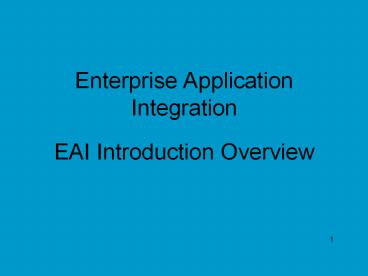Enterprise Application Integration EAI Introduction Overview - PowerPoint PPT Presentation
1 / 24
Title:
Enterprise Application Integration EAI Introduction Overview
Description:
Enterprise Application Integration EAI Introduction Overview EAI OVERVIEW What is EAI? The History of EAI Components of EAI Levels of Integration A Comparison EAI ... – PowerPoint PPT presentation
Number of Views:1440
Avg rating:3.0/5.0
Title: Enterprise Application Integration EAI Introduction Overview
1
Enterprise Application IntegrationEAI
Introduction Overview
2
EAI OVERVIEW
- What is EAI?
- The History of EAI
- Components of EAI
- Levels of Integration A Comparison
- EAI and Business Processes
- Advantages of EAI Technology
3
What is EAI?
- EAI Enterprise Application Integration
- B2B Business to Business
- B2C Business to Consumer
- A2A Application to Application
- E2A End to Anywhere
- Web Services
- .NET Platform
4
Application Integration Types
Process Integration-Oriented
Orchestration
Portal-Oriented
Presentation
Service-Oriented
Abstraction
Information-Oriented
Metadata Management
5
Data-Oriented Application Integration
User Interface
User Interface
Logic
Logic
Data
Data
Transformation Formatting
6
What is EAI?
- Enterprise Application Integration (EAI) is the
integration of new application software such as
middleware tools with existing software which
provides the functionality that supports the
enterprises business processes.
7
What is EAI?
- EAI comprises the challenge of efficiently
linking together diverse systems and applications
across the enterprise, allowing the organization
to keep pace with and respond to market changes
in real time.
8
What is EAI?
- EAI Solutions leverage a framework-based approach
to accomplish - Straight through processing, which allows the
propagation of real-time information throughout
the enterprise. - The capability to extend the enterprise to have a
closer relationship with employees, customers and
partners. - Deploying tools to lower the total cost per
transaction, resulting in higher returns on
technology investments. - The flexibility to incorporate new leading edge
technologies, while minimizing risk of failed
user acceptance.
9
EAI Definition
- Enables organizations to establish a technology
infrastructure that seamlessly links
heterogeneous business applications both
packaged and internally developed into one
unified system so processes and data can be
shared throughout the company and beyond, to
include partners, customers and other
stakeholders.
10
The High Level Stack
Databases
Applications
Middleware Services
Info Formats Movement Standards
Information-Oriented
Service-Oriented
Infrastructure Management
Enabling Technology Standards
Domain Specific Extensions
Trading Partner Specific Extensions
Format Standards
Process Standard
Vertical Standards
Adapters
BPI
BAM
Design and Deployment
Transformation
Metadata Mgmt. (Repository Services)
Platforms and Messaging
Network
11
Enterprise Application Integration
- A CEO once aptly described the current state of
most corporate IT structures as modern cities
connected by dirt roads.
12
Whats Driving Change in Business?
- Business rationalization, ROI
- Need for real-time integrated data
- Mergers acquisitions
- Legacy system limitations
- Shorter life-cycles
13
Whats Driving Change in Business?
- Need for direct customer or vendor relationships
- Automated streamlined business processes
- e-Business globalization
14
Todays Business Reality
15
Enterprise Integration Solution
Customer
Supplier
BusinessProcess Management(BPM)
Reseller
Exchange
EAI
B2Bi
B2Bi
Distributor
Mfg. BSP
PackagedApps
CustomApps
LegacyApps
AppServers
Service BSP
Logistics BSP
16
EAI Observations
- Business issue and is bottom line focused
- Infrastructure is sold via a business imperative
- Critical to corporate e business strategies
- Distinct market identified by users as strategic
- Successful EI requires business process,
technical and product understanding
17
Guiding Principles for EAI Solutions
- Clear IT Strategy mapped to Business Strategy
- Mapping of corporate process and data models
- Plan ahead for EI - investment vs. cost
justification - Formulate an EI architecture based on integration
characteristics - Establish clear lines of ownership and
accountability - Evaluate vendors on commercials, stability,
references, strategy - Evaluate technologies - scalability, flexibility,
customization, standards - Invest in the right skills - Solution
Integration Architects - Pilot the desired solution, but in a real
environment - Ensure tools and processes in place for
end-to-end service mgmt
18
EAI History
- EAI has its roots in distributed computing
- Initial EAI projects were Point to Point
- FTP file transfer was the first type of
integration - Second Generation EAI
- Created by IBM
- Message Queuing Technology
- Third Generation EAI
- Vitria, TIBCO Others
19
Immediate and Near Term Benefits
- Immediate
- Faster/higher quality of information
- Results Efficient decision making
- Integration of Best-of-breed applications
- Results Flexibility to change/grow
- Data integrity
- Results Reduced risk
20
Immediate and Near Term Benefits
- Near-term
- Supports growth
- Results Standard platform
- Extend enterprise to customers/partners
- Results B2x capability
- Reduce back office cycle time
- Results Increase efficiencies, decrease costs
21
Customer Benefits
- It can dramatically reduce redundancies.
- It can improve efficiency and effectiveness of
systems and employees. - It creates a competitive advantage for our
clients over their competition.
22
Customer Benefits
- It can improve the speed and functionality of
applications. - It can leverage past investments for improved
performance. - It can increase productivity and the accuracy of
information.
23
Invest in an Event-driven Enterprise
- EAI technology investments should yield
- Process driven integration that spans business
services - Real time notification of events and changes in
key performance indicators - Personalized information access
24
Invest in an Event-driven Enterprise
- EAI technology investments should yield
- Ubiquitous access to information
- A framework to extend beyond the corporate
firewall to mobile devices

